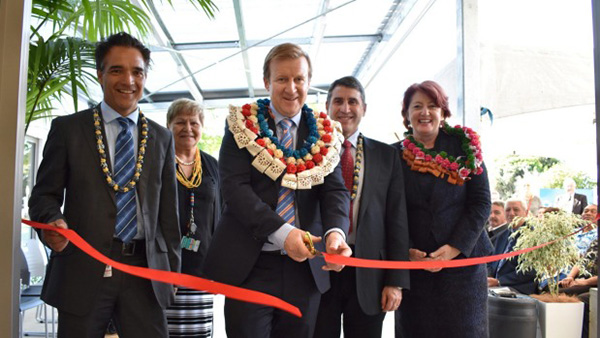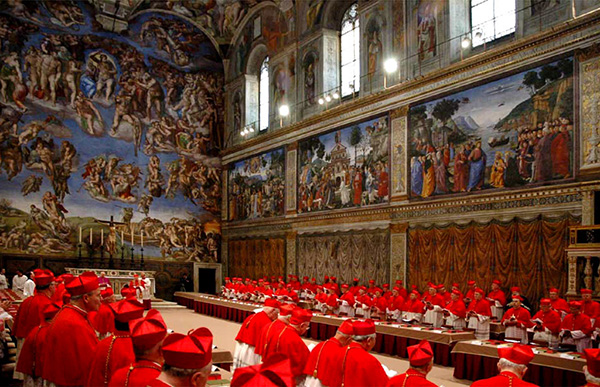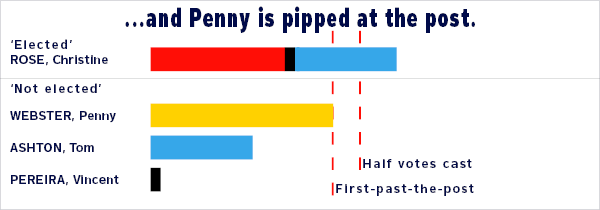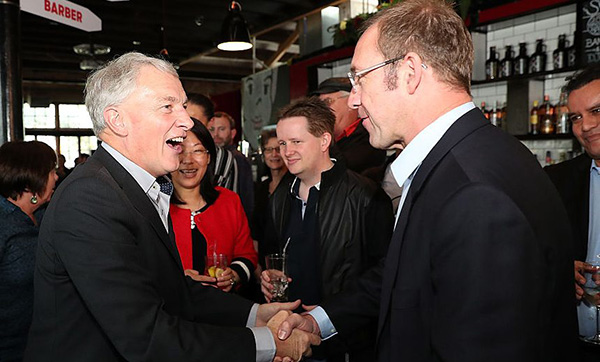Healing unhealthy health-board ballots

Missing the Cut: As magnificent a multi-district-health-board chairman as he is, the only member of the Waitematā District Health Board included in the ribbon-cutting dignitaries for the North Shore Hospital’s $9.9 million outpatient unit was Dr Lester Levy, second from right, who is an appointed member. None of the seven elected members made the cut. image Stuff
The first requirement of a voting system is to reflect voters’ preferences.
First-past-the-postfirst-past-the-post is probably better described as single-round-winner-takes-all, given that the ‘post’ is the close of voting, and not a majority of votes cast does one thing and one thing only: it reveals voters’ first preferences.
But in the real world of human interactions, second and subsequent preferences are often as important. An illuminating scenario is where two people plan a date and find that the other’s first preference of eatery—Cambodian and Irish bar respectively—is deeply unattractive.
If the two respect each other’s aversion to their first choices, a short discussion reveals that each’s second preference is Italian, and a beautiful relationship is born. The alternative scenario—wherein the more dominant of the pair insists on the boisterous Irish bar, and the less dominant spends an evening enduring noise levels that prevent meaningful conversation—is beginning of a short-lived relationship, doomed from the first date by that all-to-revealing lack of respect.
Most voters are probably unaware, when they tick their preferred candidate or candidatesin the case of multi-seat electorates, that they may be helping their least-preferred choice become elected. Some in this situation will experience buyer’s remorse and belatedly realise that they should have voted tactically—such as for their second preferenceor subsequent preferences, in a multi-seat contest, who stood a far greater chance of success. The conceptionally simplest alternative is runoff elections, where successive rounds winnow down the candidates until there are two left standing, at which point first-past-the-post, entirely fairly, delivers the coup de grâce.

Ratzinger Runoff Rules: The runoff elections to elect a pope are particularly demanding given the requirement for the winner to receive a two-thirds supermajority—Benedict XVI rescinded a change made by John Paul II that effectively abolished the two-thirds majority requirement, after 33 or 34 runoff rounds had taken place. But even without a supermajority being required, runoff elections are too expensive, disruptive, and subject to gaming, to be used for the likes of local-body elections, which is where New Zealand single transferable voting comes to the rescue. image Holy Cross Catholic Church, Nicosia
The most iconic example of a runoff electionbut one that additionally requires a two-thirds majority for the winner is that to elect the pope of the Catholic Church. The theatre of the Saint Peter’s Square crowd watching for the tell-tale white smoke is magnificent, but it is a far from practicable model for routine elections. Nor are the runoff elections held in France, despite them being a tolerated tradition there. The cost and disruption of getting voters back to the polls for successive eliminations is not something the rest of the democratic world has been prepared to tolerate. From 1856, various instant-runoff systems have been developed and implemented to obviate the need to get voters back to the ballot box. But the counting processes were famously time consuming and, consequently, aside from a few outposts, modern democracy for its first two centuries was synonymous with first-past-the-post.
It took a New Zealand team, in a circa-2000 world-first, to produce a fit-for-purpose preference voting system. It was achieved by marrying Meek’s method of processing preferences with computer-processing. In the all-too-familiar pattern of New Zealand innovation, the system, having been available from the 2004 local-body elections onward, was only used by 8 of New Zealand’s 78 councils in 2016. While Wellington gets it—the city council, from the get-go; Greater Wellington Regional, from 2013—the Auckland region has remained oblivious. This is particularly reprehensible given the 2007–2009 royal commission process. The commissioners proved to be as oblivious to the inherent flaw in first-past-the-post as the next person, who at least has the excuse that it is not their job to know.
When preference voting was introduced, it was made mandatory for the election of district health board representatives, but was left optional for local and regional territorial authorities. The latter was fundamentally inappropriate. The exploration of the deficiencies of first-past-the-post and the options for its replacement needed to happen—still needs to happen—at the national level. The logistics of the explorations needed are absurdly onerous, left to be done council by council—rather like requiring 78 councils to each run its own royal commission of inquiry. When preference voting was introduced, the proximate motivation was to increase the diversity of district health board representation, hence it being made mandatory. To secure the main prize, preference voting in local body elections was allowed to be optional.

First-Past-the-Post Crudity: When the Rodney Ward elected its first representative onto the governing body of the then new Auckland Council, the candidate probably most preferred was the first runner-up. In this preference-voting approximation, it is crudely assumed that the second preferences of the first candidate eliminated, given his apparent politics, would all have gone to Christine Rose. Similarly crudely, given that Tom Ashton was overtly opposing Penny Webster it is assumed that all his second preferences would also have gone to Penny’s principal opponent. chart Mahurangi Magazine
An inevitable consequence is that the residents of 90% of councils are faced with two methods of voting during local-body elections, which is a recipe for spoiled ballot papers. Use a tick where a ranking is required, and the vote is deemed informaloften unnecessarily. For example, if a voter was to tick no more candidates than there were positions on a preference voting ballot, the preferences deserve to be automatically averaged. This has led to high rates of blank and invalid district health board ballots, which is hardly a recipe for addressing the already dismal turnout rates. A common reaction is to call for a return to the old, first-past-the-post system of electing health board representatives, to be spared the dauntingly long list of, at-large, candidates—28 apiece for the Auckland and Counties Manukau district health boards in 2016. The first district health board elections, in 2001, elected representatives from constituencies within each health board district—Auckland and Waitematā each had three, and Counties Manukau had five. While this vastly reduced the number of candidates for each contest, it was also great for ensuring a lack of diversity, hence the change to at-large elections. But rather that revert from at-large to diversity-stifling constituencies, there are at least three easily envisaged improvements available.
One improvement would be facilitated by online voting. By allowing voters to drag-and-drop candidates into a short list or into a discard group, a 28-candidate list could be quickly tamed, then drag-and-drop the remaining candidates into the order preferred. At that point, the voter would be reminded that it is entirely their choice as to whether they rank seven or fewer candidates, or all those standing—for which the Waitematā District Health Board in 2016 was a merciful 16. District health boards are the perfect testbed for online voting in Aotearoa. Firstly, the boards are only semi-democratic—the Labour-led government that established them didn’t trust the task sufficiently to elected representatives, and mandated that up to four board members be appointed, by the Minister of Health. Also, governments have proved to be more than ready to dump the elected representatives and replace them with commissioners, when it suits their purposes. So, the first whiff of a hacked online election result… The second reason for trialling district-health-board online voting is that this is where there is an awareness that there is a problem, even if some spurious conclusions are reached. In 2013, the proportion of blank or invalid district health board votes ranged from 9.5–22.4%, in contrast with only 0.4–13.9% for local government elections. If Auckland District Health Board is any indication, the 2016 result appears to have been worse—23.2% of ballots returned blank or informal, compared to 21.9% in 2013.

Straggling Behind Estonia: As famously rapid adopters, and citizens of the world’s first democracy, New Zealanders should be deeply ashamed of their government’s failure to even trial online voting. The district health board elections, with their clumsy implementation of preference voting, are the perfect arena to trial online voting in Aotearoa, and finally begin to make up Estonia’s 16-year head start. Here Howick Intermediate students participate, in 2016, in the evidence-based Kids Voting programme that should, long since, have been provided to all intermediate and college students. image Auckland Council
The second improvement isn’t reliant upon online voting. Candidates are already permitted to have their party or other slogan on the ballot paper. If this was used to include their ranking on their party’s list for that specific contest, the utility for voters would be such that they would enjoy an advantage over those candidates less transparent about their party affiliation, if any. The immediate effect would be that parties that were reluctant about dropping the various guises they campaign under, would cede district health board representation to those that weren’t. With the Green’s health portfolio now in the hands of high-powered parliamentarian Julie Anne Genter, by 2019, the party should be well-placed to field strong, ranked, seven-person ‘lists’ for each of the New Zealand’s 20 district health boards. The role, particularly if combined with local board representation, is the perfect proving ground for a party’s Parliamentary candidates, whilst paying a living wage.
A significant reason for low local-body turnout rates is a lack of knowledge of the policies and politics of the candidates. Probably because of long-standing cynicism about party politics at the national level, political parties generally field their candidates via arms-length organisations, such as the spectacularly unsuccessful 2016 Auckland Future ticket. If candidates plan to vote along party lines, voters have right to know their party affiliation, and local body politics would be far healthier if these affiliations were coaxed out into the sunlight. The Green Party is already leading the way, in local board contests, although its 2016 performanceno mayoral, one regional and three city council representatives was not nearly as salubrious as its 2013 Wellington wins of one mayoral, two regional and three city council representatives.
Short of a government suddenly seeing political capital in addressing the mess created by the single transferable vote legislation, in the absence of leadership by the district health boards, combinedthe incorporated society District Health Boards New Zealand was struck off 31 August 2012 or individually, or by the Ministry of Health, the best hope for the advancement of preference voting is that Auckland Council gets its house in order. This is the third and perhaps easiest improvement, and it is already on offer. If the Auckland region was to adopt preference voting, many other jurisdictions would follow. Then, if the government was to incentivise the stragglers by picking up the cost of a centralised online local-body voting system, the current disparate, costly and confusing systems could be simplified and standardised. This is also in line with the Local Government Commission’s move to encourage the sharing of services such as geographic information systems, across several councilsThe ideal, of course, is to share amongst all territories, to produce seamless, accessible systems. . But back to that third option:

Labour Candidate Creams Mayoralty: Phil Goff’s principal opponent in the 2016 first-past-the-post race for the mayoralty, Vic Crone, could hardly have performed more poorly had she stood proudly as the National Party candidate she essentially was. Goff, of course, after 32 years as a Labour Party parliamentarian, benefitted from that cachet without his party’s name needing to be on the ballot paper. Admittedly, his prospects were possibly helped by his centre–right leanings, but this may have also greatly benefitted the real star of the election, Chlöe Swarbrick, whose brand was self-evident. In an election that should have been about housing affordability, the only mainstream media excitement was that generated by Chlöe Swarbrick and Tessa Berger. image Fiona Goodall
The Governance Framework Review Report currently being considered by Auckland Council strays outside its remit in exploring at-large wards. This is where the number of wards is reduced and there are several ward members representing a single ward. Unless accompanied by preference voting, this is known to reduce the diversity of representation, yet the report fails to make a single reference to preference votingor to the single-transferable-vote system, or to preference voting by any other name. It is probable that the report’s author was as oblivious of the flaw in first-past-the-post as were Auckland’s royal commissioners, but at least the latter acknowledged the option, albeit ineffectually:
A number of submitters proposed that in future, councils should adopt single transferable voting. The Commission makes no recommendation on this, because it was not persuaded that the adoption of this voting system would assist in solving Auckland’s problems.
The two objectives of the royal commission, as set out in its terms of reference, were to maximise, in a cost-effective manner:
(a) the current and future well-being of the region and its communities; and
(b) the region’s contribution to wider national objectives and outcomes.

Bugger Evidence-Based Policymaking: Auckland Council spent $1 160 960 on its Kombi-centric communications and engagement for which there was little or no evidence of likely efficacy, but less than 4.3% of that figure on the solidly evidence-based Kids Voting programme. And while Kids Voting makes for great press, only about 8% of students who should be shadow voting in the intermediates and colleges of the region currently are, and this is twice as good as for the balance of Aotearoa. image Auckland Council
Nothing here about ‘solving Auckland’s problems’, but preference voting certainly meets the first objective: the cost-effective maximising of the region’s well-being. Legitimate local government depends upon the democratic election of representatives, and for this there are two essentials: a legitimate turnout; and a legitimate result. In 2016, Phil Goff was elected mayor of New Zealand’s largest territorial authority with the support of barely 18% of registered voters. In the event, under preference voting Vic Crone would still have fallen well short, even if she’d picked up every spare John Palino and Mark Thomas preference. Having wrecked his own reputation, Palino only attracted 22 387 votes, 86 541 fewer than in 2013. But in 2013, a very different scenario might have played out, had the grubby Brown–Chuang desecration of the Ngāti Whatua Room been revealed earlier. Despite being on the wrong side of the 61%-left-39%-right voter’s first preferences, to become mayor in 2013, Palino would only have needed to pick off 17% of the support for the about-to-be-outed Brown.
Preference voting is an esoteric subject that shouldn’t need to exercise readers of the Mahurangi Magazine, if the state delivered on its responsibility to ensure that electoral systems were fit for purpose. It is likely that struggling with the district health board ballots has been the last straw for many voters who were already finding it challenging to make informed choices in the local-body elections, and that this has contributed to the inexorable downward trend in turnout. This is a blight on New Zealand’s otherwise proud 108-year-old history of directly elected hospital district representation. The Hippocratic Oath to abstain from doing harm should be extended to the electoral system used for district health boards, which is currently harming both local body and health board representation. But while a portion of the decline in local body turnout might be treated by addressing the unmindful implementation of the single transferable vote system, the full decline will only be staunched by school and college students learning democracy by doing. Auckland Council spent $49 424 helping to deliver the solidly evidence-based Kids Voting programme to a fraction of the students who might have benefited from it, but more than 23 times that on flummery for which there was not a skerrick of evidence.
Short of Auckland Council pulling its weight by 12 September, greater transparency with party affiliations in district health board elections would be a good start initial treatment for what ails its electoral process.
Continual improvementthe wartime United States-developed manufacturing strategy that, post-war, helped Japan became the world’s second largest economy is infinitely preferable to perpetual backsliding.
